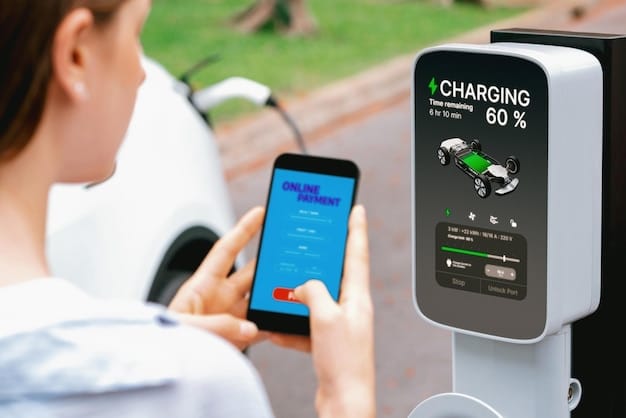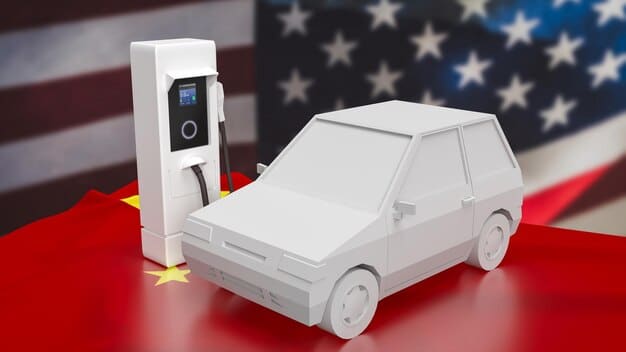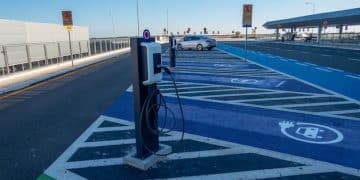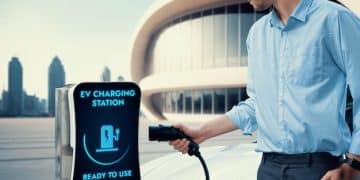US Government Investment: $5B for EV Charging Network – Timeline

The US government has announced a \$5 billion investment in a nationwide electric vehicle (EV) charging network, aiming to deploy charging stations across the country and accelerate the adoption of electric vehicles; the timeline for this initiative spans over five years, with various phases of planning, station deployment, and network expansion.
The US Government Announces $5 Billion Investment in Electric Vehicle Charging Network: What’s the Timeline? This ambitious project aims to revolutionize the EV landscape in the United States, but when can drivers expect to see these new charging stations popping up across the country?
US Government’s \$5 Billion EV Charging Plan: An Overview
The Biden administration has committed \$5 billion to expand the nation’s electric vehicle charging infrastructure, addressing a critical barrier to EV adoption. This investment, part of the Bipartisan Infrastructure Law, aims to create a convenient, reliable, and equitable charging network.
The plan focuses on deploying charging stations along designated Alternative Fuel Corridors (AFCs), primarily along interstate highways. The goal is to ensure that EV drivers can travel long distances without worrying about running out of power.

Key Objectives of the Investment
The investment targets several key objectives to ensure the success of the EV charging network. These include:
- Expanding Charging Infrastructure: Increasing the number of charging stations, particularly in underserved areas.
- Ensuring Reliability: Maintaining high uptime and ensuring that chargers are functional and available.
- Promoting Interoperability: Establishing standards for chargers to work with all EV models.
- Driving Economic Development: Creating jobs in manufacturing, installation, and maintenance of charging infrastructure.
These objectives align with the broader goal of accelerating EV adoption, reducing greenhouse gas emissions, and enhancing the nation’s energy independence. The plan is designed to stimulate the EV market and support a sustainable transportation future.
In summary, the US government’s \$5 billion investment in EV charging infrastructure represents a significant step toward electrifying transportation and mitigating climate change, aiming to provide reliable EV charging and encourage widespread adoption.
Timeline Breakdown: Key Phases and Milestones
The timeline for deploying the \$5 billion EV charging network spans several years and involves multiple phases. Understanding this timeline is crucial for anticipating when and where these chargers will become available.
The initial phases focus on planning, setting standards, and providing funding to states. Subsequent phases involve the actual deployment of charging stations and ongoing maintenance.
Phase 1: Initial Planning and Funding (2022-2023)
- Establishment of NEVI Formula Program: The National Electric Vehicle Infrastructure (NEVI) Formula Program was established to provide funding to states for EV charging infrastructure.
- State EV Infrastructure Deployment Plans: States were required to submit EV infrastructure deployment plans outlining their strategies for using the funds.
- Approval of State Plans: The Joint Office of Energy and Transportation approved state plans, paving the way for funding allocation.
Phase 2: Early Deployment and AFC Build-Out (2023-2024)

This phase focuses on building out the charging infrastructure along designated AFCs, ensuring that EVs can travel across states with reliable access to charging.
- Installation of Charging Stations: States begin installing charging stations along AFCs, prioritizing locations with high traffic and demand.
- Implementation of Federal Standards: Charging stations must comply with federal standards to ensure interoperability and reliability.
- DC Fast Charging Build-Out: Emphasis is placed on installing DC fast chargers, which can provide a significant charge in a short amount of time.
Phase 3: Network Expansion and Rural Areas (2024-2027)
The final phase involves expanding the charging network beyond AFCs and into rural and underserved areas. This ensures that all communities have access to EV charging.
- Expansion Beyond AFCs: Charging stations are deployed in communities and areas not directly served by AFCs.
- Equity Considerations: Efforts are made to ensure that charging infrastructure is accessible to all, regardless of location or income.
- Ongoing Maintenance and Upgrades: Charging stations are regularly maintained and upgraded to ensure reliability and performance.
In conclusion, the timeline for the US government’s \$5 billion EV charging network is structured around planning, initial deployment, and network expansion, ensuring long-term affordability and reliability of the new infrastructure.
Challenges and Potential Roadblocks in the Timeline
While the \$5 billion investment represents a significant step forward, several challenges and potential roadblocks could impact the timeline for deploying the EV charging network.
These challenges include supply chain disruptions, regulatory hurdles, workforce shortages, and technological advancements.
Supply Chain Disruptions
The global supply chain has been strained in recent years, impacting the availability of components needed for EV charging stations. Delays in obtaining these components could slow down the deployment process.
Manufacturers of charging stations rely on a variety of components, including semiconductors, connectors, and enclosures. Shortages of these components can lead to production delays and increased costs.
To mitigate this risk, policymakers and industry stakeholders are working to diversify supply chains and increase domestic manufacturing capacity. This would reduce reliance on foreign suppliers and make the charging network more resilient to disruptions.
Regulatory Hurdles and Permitting Delays
Navigating the regulatory landscape can be complex, with varying requirements at the federal, state, and local levels. Permitting delays can also slow down the installation of charging stations. State and local governments will need to stream line their processes for infrastructure construction to keep the project on track.
Streamlining the permitting process and clarifying regulatory requirements can help accelerate the deployment of charging stations. Collaboration between government agencies and industry stakeholders is essential to address these challenges.
Standardizing regulations and providing clear guidance to developers can reduce uncertainty and encourage investment in EV charging infrastructure.
Workforce Shortages and Training Needs
Installing and maintaining EV charging stations requires a skilled workforce. Workforce shortages, particularly in areas such as electrical contracting and engineering, could pose a challenge.
Investing in workforce development programs and training initiatives can help address these shortages. These programs can provide individuals with the skills needed to install, maintain, and repair EV charging stations.
Collaboration between educational institutions, industry partners, and government agencies can ensure that the workforce is prepared to support the growing EV charging network.
In summary, challenges such as supply chain disruptions, regulatory complexities, and workforce shortages could impede the timeline for deploying the EV charging network. Proactive measures are needed to mitigate these risks and ensure the plan can overcome these obsticles.
Impact on Electric Vehicle Adoption and the Market
The \$5 billion investment in EV charging infrastructure is expected to have a significant impact on electric vehicle adoption and the broader market.
By expanding the availability of charging stations, the plan aims to alleviate range anxiety and make EVs a more practical choice for consumers.
Increased Consumer Confidence
One of the primary barriers to EV adoption is range anxiety – the fear of running out of power before reaching a charging station. By deploying charging stations along major highways and in communities, the plan can increase consumer confidence in EVs.
With a reliable charging network, EV drivers can travel long distances without worrying about running out of power. This can make EVs a more attractive option for consumers who are hesitant to switch from gasoline-powered vehicles.
In addition, the plan includes measures to ensure that charging stations are reliable and well-maintained. This can further increase consumer confidence and encourage EV adoption.
Acceleration of EV Sales
The increased availability of charging stations is expected to accelerate EV sales. As EVs become more practical and convenient, more consumers are likely to consider them as their next vehicle.
The plan can help drive down the cost of EVs. Increased demand can lead to economies of scale, making EVs more affordable for consumers. Government incentives and tax credits can also lower the upfront cost of purchasing an EV.
The plan is likely to spur innovation in the EV market. Increased competition can lead to advancements in battery technology, charging speeds, and vehicle performance.
Economic Benefits and Job Creation
The EV charging network is expected to generate economic benefits and create jobs. The installation, maintenance, and operation of charging stations can create jobs in a variety of sectors.
The plan can help stimulate economic activity in communities across the country. Charging stations can attract visitors and increase spending at local businesses.
The plan can contribute to the growth of the EV industry, creating new opportunities for entrepreneurs and small businesses. This can help diversify the economy and create new sources of wealth.
In summary, the government’s investment in EV charging is beneficial for customers, businesses, and the government alike, promising economic benefits and increased adoption of greener vehicles.
Long-Term Goals and Sustainability of the Network
The long-term goals of the EV charging network extend beyond simply deploying charging stations. The plan aims to create a sustainable ecosystem that supports the widespread adoption of EVs.
These long-term goals include reducing greenhouse gas emissions, enhancing energy independence, and promoting economic development.
Reducing Greenhouse Gas Emissions
One of the primary goals of the EV charging network is to reduce greenhouse gas emissions from the transportation sector. EVs produce zero tailpipe emissions, making them a cleaner alternative to gasoline-powered vehicles.
To maximize the environmental benefits of EVs, the plan also promotes the use of renewable energy sources to power charging stations. This can further reduce greenhouse gas emissions and enhance the sustainability of the network.
The plan includes measures to ensure that charging stations are energy-efficient and environmentally friendly. This can help minimize the environmental impact of the network and promote sustainable transportation.
Enhancing Energy Independence
The EV charging network can help enhance the nation’s energy independence by reducing reliance on foreign oil. EVs can be powered by electricity generated from domestic sources, such as renewable energy, nuclear power, and natural gas.
This can reduce the vulnerability of the nation’s economy to fluctuations in global oil prices. It can help promote energy security and create a more stable energy supply.
The plan also encourages the development of a domestic EV supply chain, reducing reliance on foreign manufacturers. This can create jobs and boost the nation’s economy.
Promoting Economic Development
The EV charging network can promote economic development by creating jobs, stimulating economic activity, and attracting investment. The plan can help support the growth of the EV industry and create new opportunities for entrepreneurs and small businesses.
The plan can help revitalize communities by providing access to clean transportation and creating new economic opportunities. This can help reduce poverty and improve the quality of life for residents.
The EV charging network is expected to have lasting impacts on the EV ecosystem in the United States for future generations. The long-term goals of the plan align with broader efforts to create a more sustainable and prosperous future.
In summary, the long-term goals of sustainability and economic growth are highly important to the EV charging network, and will be helpful in creating a system used for years to come.
Future Innovations and Advancements in EV Charging
The EV charging industry is constantly evolving, with new innovations and advancements emerging regularly. These advancements can improve the performance, convenience, and sustainability of EV charging.
Some of the key areas of innovation include charging speeds, wireless charging, and smart charging technologies.
Faster Charging Speeds
One of the most significant areas of innovation is charging speeds. Faster charging speeds can reduce the amount of time it takes to charge an EV, making it more convenient for drivers. Advancements in battery technology and charger technology are enabling faster charging speeds.
Ultra-fast chargers, which can deliver a significant charge in a short amount of time, are becoming more common. These chargers can provide drivers with a quick and convenient charging experience, particularly on long trips.
Researchers are also working on new charging technologies, such as solid-state batteries and high-voltage charging systems, that could further reduce charging times.
Wireless Charging
Wireless charging is another promising area of innovation. Wireless charging allows EVs to be charged without the use of cables, making it more convenient for drivers. Wireless charging systems can be installed in parking spaces, garages, and even roadways.
Wireless charging technology is still in its early stages of development, but it has the potential to revolutionize the EV charging experience. Wireless charging could make it easier for drivers to charge their EVs at home, at work, or on the go.
Researchers are working on improving the efficiency and safety of wireless charging systems, as well as developing new applications for the technology.
Smart Charging Technologies
Smart charging technologies can optimize the use of EV charging infrastructure and improve the efficiency of the electricity grid. Smart charging systems can adjust charging rates based on grid conditions, reducing the strain on the grid during peak demand periods.
Smart charging can also enable EV owners to save money on their electricity bills by charging their EVs during off-peak hours. Smart charging systems can be integrated with renewable energy sources, making EV charging more sustainable.
Utilities and grid operators are working on deploying smart charging technologies to support the growing EV charging network. These technologies can help ensure that the grid can handle the increased demand from EVs.
In short, advancements are constantly being made to EV chargers and charging stations making them safer, more efficient, and more accessible than ever.
| Key Point | Brief Description |
|---|---|
| ⚡ Investment Goal | Expand EV charging infrastructure nationwide for reliable long-distance travel. |
| 📅 Timeline | Deployment spans several years, with planning, initial build-out, and expansion phases. |
| 🚧 Challenges | Supply chain issues, regulatory hurdles, and workforce shortages can affect progress. |
| 🌱 Sustainability | Aims to reduce emissions and enhance energy independence with renewable energy integration. |
Frequently Asked Questions
▼
The main goal is to expand the electric vehicle charging infrastructure across the United States, making EV travel more reliable and convenient.
▼
The timeline varies by state, but the initial build-out along Alternative Fuel Corridors is expected between 2023 and 2024.
▼
Ongoing maintenance and upgrades are part of the plan to ensure reliability and performance, with continuous monitoring and scheduled improvements.
▼
Challenges include supply chain disruptions, regulatory delays, and workforce shortages, which could impact timely deployment, but are being addressed.
▼
This initiative aims to bolster confidence in electric vehicles, accelerate EV adoption, and drive economic growth, creating a sustainable transportation future.
Conclusion
The US government’s \$5 billion investment in EV charging infrastructure marks a pivotal moment for electric vehicle adoption. While challenges remain, the commitment to expanding and improving charging networks promises a future where EVs are a practical and accessible choice for all Americans.





